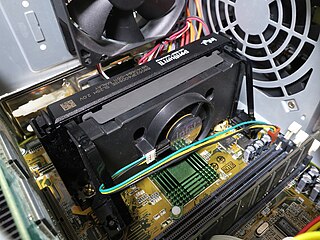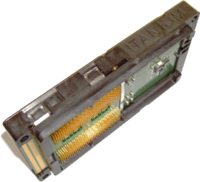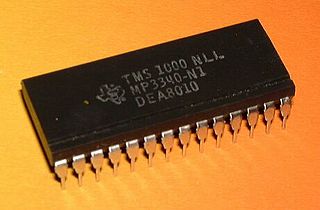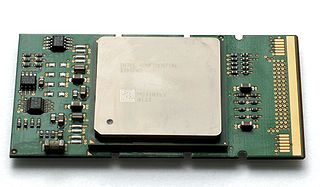
Athlon is the brand name applied to a series of x86-compatible microprocessors designed and manufactured by Advanced Micro Devices (AMD). The original Athlon was the first seventh-generation x86 processor and was the first desktop processor to reach speeds of one gigahertz (GHz). It made its debut on June 23, 1999.

The IntelDX4 is a clock-tripled i486 microprocessor with 16 KB L1 cache. Intel named it DX4 as a consequence of litigation with AMD over trademarks. The product was officially named the IntelDX4, but OEMs continued using the i486 naming convention.

The Pentium III brand refers to Intel's 32-bit x86 desktop and mobile microprocessors based on the sixth-generation P6 microarchitecture introduced on February 26, 1999. The brand's initial processors were very similar to the earlier Pentium II-branded microprocessors. The most notable differences were the addition of the SSE instruction set, and the introduction of a controversial serial number embedded in the chip during the manufacturing process.

Socket 7 is a physical and electrical specification for an x86-style CPU socket on a personal computer motherboard. It was released June 1995. The socket supersedes the earlier Socket 5, and accepts P5 Pentium microprocessors manufactured by Intel, as well as compatibles made by Cyrix/IBM, AMD, IDT and others.

Xeon is a brand of x86 microprocessors designed, manufactured, and marketed by Intel, targeted at the non-consumer workstation, server, and embedded system markets. It was introduced in June 1998. Xeon processors are based on the same architecture as regular desktop-grade CPUs, but have some advanced features such as support for ECC memory, higher core counts, support for larger amounts of RAM, larger cache memory and extra provision for enterprise-grade reliability, availability and serviceability features responsible for handling hardware exceptions through the Machine Check Architecture. They are often capable of safely continuing execution where a normal processor cannot due to these extra RAS features, depending on the type and severity of the Machine Check Exception. Some also support multi-socket systems with two, four, or eight sockets through use of the Quick Path Interconnect bus.

The K6-2 is an x86 microprocessor introduced by AMD on May 28, 1998, and available in speeds ranging from 266 to 550 MHz. An enhancement of the original K6, the K6-2 introduced AMD's 3DNow! SIMD instruction set, featured a larger 64 KiB Level 1 cache, and an upgraded system-bus interface called Super Socket 7, which was backward compatible with older Socket 7 motherboards. It was manufactured using a 0.25 micrometre process, ran at 2.2 volts, and had 9.3 million transistors.

Slot 1 refers to the physical and electrical specification for the connector used by some of Intel's microprocessors, including the Pentium Pro, Celeron, Pentium II and the Pentium III. Both single and dual processor configurations were implemented.

Altix is a line of server computers and supercomputers produced by Silicon Graphics, based on Intel processors. It succeeded the MIPS/IRIX-based Origin 3000 servers.

Socket 5 was created for the second generation of Intel P5 Pentium processors operating at speeds from 75 to 120 MHz as well as certain Pentium OverDrive and Pentium MMX processors with core voltage 3.3 V. It superseded the earlier Socket 4. It was released in March 1994. Consisting of 320 pins, this was the first socket to use a staggered pin grid array, or SPGA, which allowed the chip's pins to be spaced closer together than earlier sockets. Socket 5 was replaced by Socket 7 in 1997.

Socket 604 is a 604-pin microprocessor socket designed to interface an Intel's Xeon processor to the rest of the computer. It provides both an electrical interface as well as physical support. This socket is designed to support a heatsink.

LGA 771, also known as Socket J, is a CPU interface introduced by Intel in 2006. It is used in Intel Core microarchitecture based DP-capable server processors, the Dual-Core Xeon is codenamed Dempsey, Woodcrest, and Wolfdale and the Quad-Core processors Clovertown, Harpertown, and Yorkfield-CL. It is also used for the Core 2 Extreme QX9775.

Socket M (mPGA478MT) is a CPU interface introduced by Intel in 2006 for the Intel Core line of mobile processors.

The HP Superdome is a high-end server computer developed and produced by Hewlett Packard Enterprise. The latest version of product, "Superdome 2" was introduced in 2010. Superdome 2 scales from 2 to 32 sockets and 4 TB of memory. When introduced in 2000, the Superdome used PA-RISC processors. Since 2002, there has been another version of the machine based on Itanium 2 processors, marketed in parallel as the HP Integrity Superdome. The classic PA-RISC Superdome was subsequently rebranded to HP 9000 Superdome. The predecessor to the Superdome was the HP V-Class.

Socket PAC611 is a 611 pin microprocessor socket designed to interface an Intel Itanium 2 processor to the rest of the computer. It provides both an electrical interface as well as physical support. This socket is designed to support a microprocessor module.

LGA 1248 is an Intel CPU Socket for Itanium processors from the 9300-series to the 9700-series. It replaces PAC611 used by Itanium 9100-series processors and adds Intel QuickPath Interconnect functionalities.


















